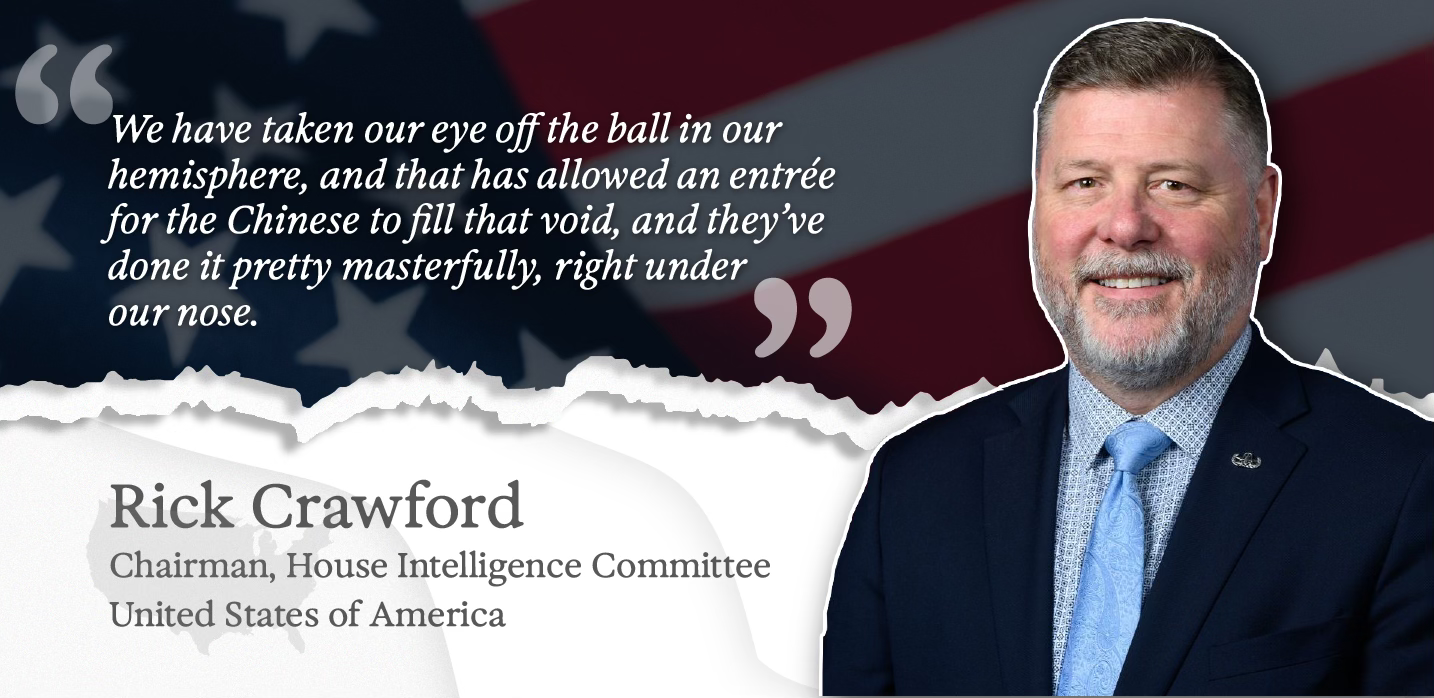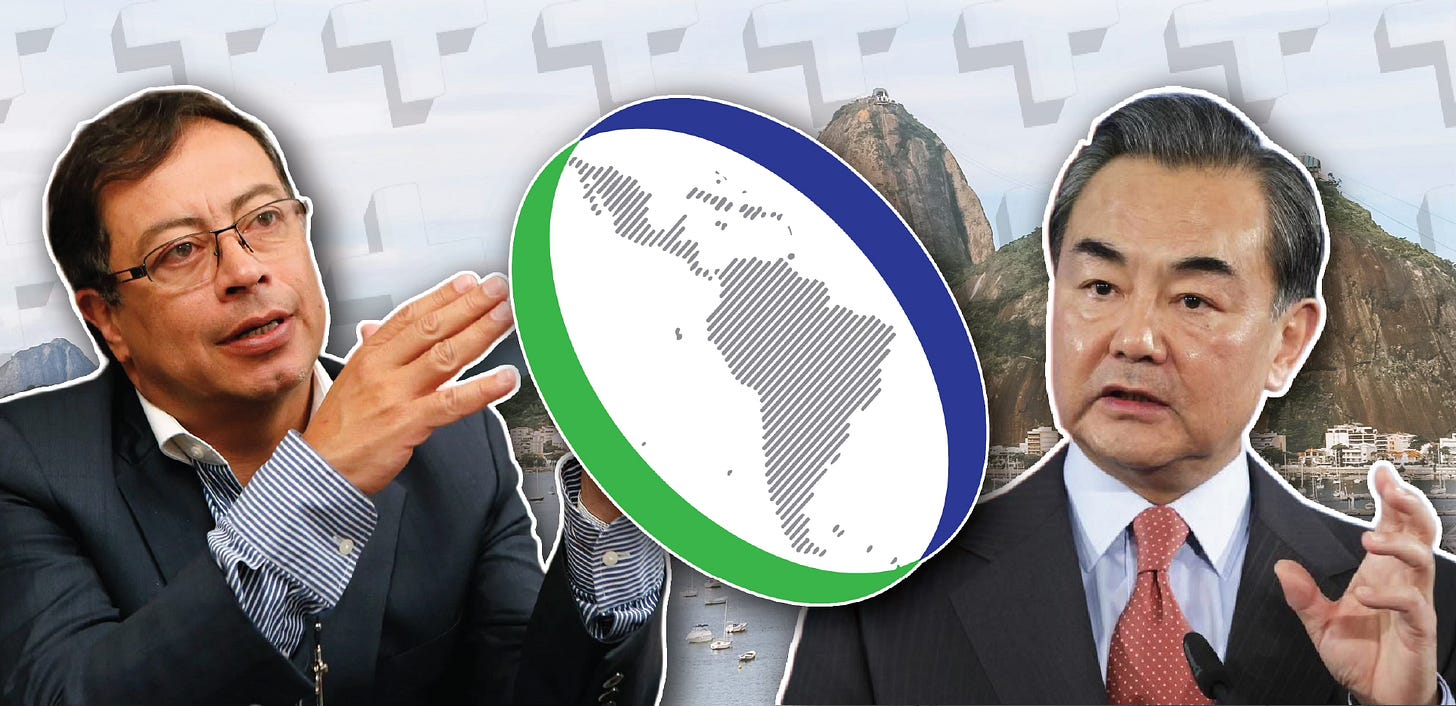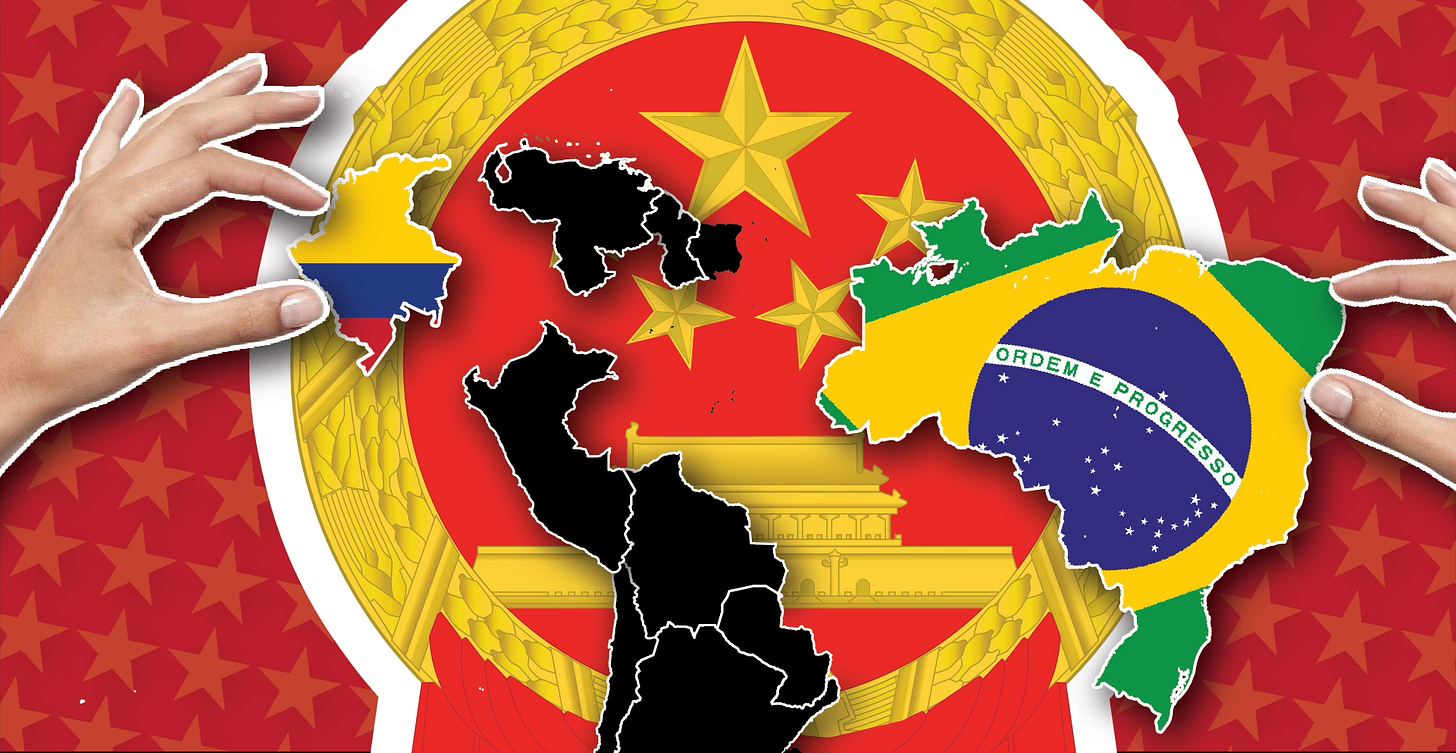Right Under Our Nose
BRICS meeting in Brazil, prep for China-CELAC, Panama ports trouble, and the PRC's comments on Haiti. Plus: the CCP International Department in LAC
Welcome to Chaufa, a China-Western Hemisphere Newsletter by CPSI.
Today’s edition covers April 21 to May 4
Listen on Spotify
The Top 5 Stories:
Chinese Foreign Minister Wang Yi attended a BRICS ministerial in Brazil and met with President Lula and presidential advisor Amorim to discuss “expanding mutually beneficial cooperation in finance, energy,” and trade. Lula also praised China’s response to the U.S. “reciprocal tariffs,” just as Chinese soybean processors picked up the pace on purchasing Brazilian beans. (Xinhua) (FMPRC)
As an aspiring global power and regional hegemon, Brazil has long forged close political ties with China in multilateral fora like BRICS. However, with the United States putting new levels of pressure on the region through tariffs, security threats, and other kinds of diplomatic coercion, Brazil seems to be harnessing its relationship with China to fulfill its longstanding desires, such as crafting an alternative the U.S. dollar, further expanding its global trade presence, and taking a more prominent global leadership role.
Venezuela’s Vice President, Delcy Rodríguez, traveled to Beijing in late April to reportedly “consolidate joint policies and strengthen trade between both countries.” She met with Chinese Vice President Han Zheng, as well as Chinese International Trade Minister Wang Shouwen. The two sides also signed new energy, oil, investment, and health-related agreements. (Xinhua)
Chinese-Venezuelan ties have been deepening over the past few years, with the two sides agreeing to notable trade, technology, and political agreements over the past few years. However, given that China is also trying to maintain close ties with Guyana, this relationship is increasingly putting Beijing in a sticky situation as Maduro’s regime has increasingly threatened Guyana’s sovereignty.
The president of Panama stressed that his government would no longer promote port development on the Isla Margarita, which is currently operated by Chinese firm Landbridge Group. Moreover, he suggested that Landbridge’s concession was “a badly given contract, it is a delinquent contract.” However, the Panama Maritime Authority later clarified that it was not aware of any possible sale of the Panama Colon Container Port.
This came as China’s State Administration for Market Regulation, the country’s top market regulator, said it was paying close attention to the proposed CK Hutchison-Blackrock port sale that would include two key Panamanian ports.
Colombian President Petro will travel to China for the IV China-CELAC ministerial. As part of the trip, he expects to sign several new “trade treaties.” Petro isn’t the only one going alone — Chilean President Boric also confirmed he will be traveling to China (and Japan) for the ministerial. Relatedly, Chinese Assistant Foreign Minister Miao Deyu met with the ambassadors of Barbados, Colombia, Honduras, and Uruguay to prepare for the upcoming CELAC ministerial. (MOFA)
It remains to be seen whether other regional leaders, including Argentine President Milei, will travel to Beijing for the summit. That said, the fact that this major meeting is coming right as the Trump Administration has made China-LAC relations a foreign policy priority provides Beijing with an opportunity to flex its diplomatic muscles. Expect eye-catching new initiatives (though these may simply be re-packaged old projects, like the bi-oceanic corridor), bilateral agreements, and even multilateral accords.
During a UN Security Council briefing on Haiti, a PRC diplomat to the UN attacked the United States for its role in Haiti’s ongoing security crisis. He notably called potential U.S. tariffs on Haiti as, “cruel and absurd, but also profoundly heartbreaking” (Global Times)
This isn’t the first time that China has pinned Haiti’s tragic security and political crisis on the United States – for example, China’s representative to the UN blamed the crisis on U.S. firearms trafficking back in 2024. But given China’s unique relationship with Haiti (they lack formal diplomatic ties, though each side has a trade office in the other’s capital) always makes any Chinese comments on Haiti’s political situation are notable.
Core Brief
Who shapes China’s LAC FP: The CCP’s International Department
It’s often easiest to describe Sino-Latin American and the Caribbean (LAC) relations in terms of “China” or “Beijing” making a certain decision. But in reality, China’s interactions with LAC involve numerous actors with their own distinct priorities and processes.
Last time, I discussed how the LAC-focused portions of the Chinese Ministry of Foreign Affairs (MOFA) operate, but this week I wanted to focus on MOFA’s underdiscussed little brother: the CCP’s International Department (ID)
Unlike MOFA, the International Department (formerly called the International Liaison Department) is not actually a part of the government of the People’s Republic of China. Rather, it is a ministerial-level department in the Chinese Communist Party (CCP) itself.
Though this distinction may seem trivial, it means that the department’s perspective and responsibilities differ significantly: rather than advancing the foreign policy of the country and interacting with other diplomats, the department is focused on “party-to-party exchanges and cooperation” to promote China’s foreign relations, showcase the CCP’s successes, expose party cadres to the world, and identify lessons from other countries to support the central leadership’s decision-making.
A quick background on the International Department
The modern iteration of the ID is a relatively new organization. Though the department predates MOFA by three years (it was founded in 1951), its activities for much of the 20th century were largely focused on cultivating ties with other left-leaning parties around the world. This often meant engagement with LAC – think the Cuban Communist Party or the Shining Path in Peru – but it also limited the scope of interaction to only one portion of the region’s political spectrum.
It was really only after the 18th National Party Congress in 2012 (which was the same congress that elevated Xi Jinping to the party’s top leadership position) that the party took a pre-eminent position in China’s foreign affairs. According to Neil Thomas, following the 18th Party Congress, as well as 2017’s World Political Parties Dialogue, the ID has “enjoyed a markedly higher profile under Xi’s advocacy of a ‘new type of political party relations.’”
Because of these changes, over the past few years, the ID has taken a more prominent role in arranging meetings with local and national LAC leaders to promote the CCP’s political agenda. This doesn’t mean that the ID is any kind of replacement for MOFA or China’s other foreign policy-focused institutions, but rather it has given the CCP a distinct avenue for engagement with the parties that themselves operate the region’s democracies and autocracies.
Who makes decisions at the International Department?
Unlike MOFA, the head of the ID is quite active in maintaining relations with LAC countries. Not only has Minister Liu Jianchao (刘建超) (and former ambassador to the Philippines) headlined multilateral regional events like 2024’s China-CELAC Political Parties Forum and an ECLA meeting in Chile, but he has also traveled around the region to countries like Nicaragua and Chile.
Aside from Liu, ID currently has five vice ministers and two assistant ministers, but it seems that only three have regular interaction with the region. Vice Minister Ma Hui (马辉), a former ambassador to Cuba, appears to be the most active, traveling to countries like Argentina, Panama, and Peru. Vice Minister Li Mingxiang (李明祥) has served as an envoy to countries like the Dominican Republic, while Assistant Minister Zhao Shitong (赵世通) has met with Brazilian legislators in Beijing.
Underneath the vice and assistant ministers, ID does have a LAC-focused office called “Bureau V.”1 Not only does this bureau initiate and maintain relationships with LAC political parties across the political spectrum, but it also “carries out research on relevant political parties, political organizations, and countries in the region.”
The International Department’s LAC activities
So what do ID activities look like in Latin America and the Caribbean? Well, for the most part, they simply seem to be holding meetings that create relationships between the CCP and politicians of all political stripes.
Some countries do appear more favored than others. A great paper from Xinyu Zhang found that about 20% of the ID’s public meetings between 2013 and 2022 were between the CCP and the Cuban Communist Party. Mexico and Brazil also featured prominently, with each country hosting roughly 10-15% of ID’s regional meetings. But Zhang found that the ID has engaged in at least 19 countries over that period, showing that the ID’s focus is broad and not just limited to large countries or governments run by left-leaning parties.
The local leaders who participate in the ID’s meetings tend to be actively partisan politicians, though this can mean various levels of responsibilities or parts of society. Unlike MOFA, the ID isn’t as focused on non-political bureaucrats with technical specialties, such as a finance ministry official or a diplomat. But their meetings do range from heads of state to legislators to grass-roots party members to former presidents to even the occasional ambassador across the left-right political spectrum.
What is discussed in ID meetings isn’t especially clear from the read-outs, but it seems that the meetings are largely centered on political matters like the Taiwan issue, establishing regular party-to-party dialogues, or engagement in multilateral fora, rather than technical topics like financing, education, or health diplomacy.2 The ID also takes advantage of these discussions to explain China’s domestic political situation and to provide a model for other political parties and governing systems, though the extent of this activity seems to vary by country.3
What to take away
The CCP’s International Department might be a lot less famous than the PRC Ministry of Foreign Affairs, but it still plays a major role in advancing China’s foreign policy across the region. Though its scope is largely constrained to political parties and discussing political topics, the department engages with at least dozens of parties across the political spectrum and in every corner of the hemisphere, creating new avenues to advance the CCP’s political priorities.

The Roundup
Politics and diplomacy
In the midst of a relatively tense period in Sino-Guyanese ties, the PRC’s new ambassador, Yang Yang (杨扬), arrived in Georgetown. Yang previously served in Thailand and the MOFA’s Foreign Security Affairs Department.
The Chinese ambassador to Chile accused the U.S. government of interfering in the development of a new super telescope in the country’s northern desert.
A delegation of senior foreign affairs-focused officials from Heilongjiang traveled to Córdoba, Argentina, to discuss agricultural goods and machinery production. They also went to Antía to review economic and cultural exchanges.
Investment, finance, and infrastructure
There was an arson attack on a hydroelectric plant owned by China International Water & Electric Corp CWE group in Biobio, prompting the Chinese embassy in Chile to warn that this kind of attack “seriously undermines the trust" of its companies in the country.
China Harbour Engineering Company (CHEC) commenced construction in Mammee Bay, Jamaica, on a new section of road for the $700 million north-south highway project.
China’s Wison New Energies signed the detailed feasibility study for an offshore LNG facility in Suriname.
Officials from the El Salvadorian city of Chalatenango Sur asked the Chinese ambassador to help build three new wells that would cost $240,000.
CMOC Group Limited of China reached an agreement to purchase the Canadian-owned Cangrejos gold and copper mining project in Ecuador. Similarly, an Australian firm sold its equity in the Cascabel copper mine to Jiangxi Copper Company Limited.
Private Chinese firm Funfeng will invest $400 million in a corn processing plant in the Salta region of Argentina.
Trade and Technology
A delegation of the PRC Ministry of Commerce and business officials led by Xiao Lu, the Department of Foreign Trade’s Deputy Director-General, traveled to Honduras to discuss agricultural product purchases. (CGTN) A large Chinese trade mission, including companies like ICBC, ZTE, and the Bank of China, also visited Argentina.
China's Guangzhou Port opened a new direct trade route to the COSCO-owned and operated Chancay mega port in Peru. The new port also inspired Beijing’s ambassador to Lima to say that bilateral relations had entered “a new historical era.” A new direct route between Zhuhai and Brazil also opened.
The U.S. Southern Command claimed that Chinese hackers recently infiltrated the Guatemalan foreign ministry’s computer network. The Central American country notably maintains diplomatic relations with Taipei instead of Beijing.
To mark 7 years of diplomatic relations, as well as to provide a contrast with Trump’s 10% universal tariff proposal, the Chinese embassy in the Dominican Republic hosted a commercial event that featured two new major business cooperation agreements on coffee beans and minerals. (CGTN)
While visiting the PRC, the Cuban Minister of Energy and Mines signed an MOU on bilateral geological and mining cooperation. Meanwhile, Lyu Weihong, the Deputy Minister of China’s General Customs Administration, traveled to Havana to discuss “training and administrative assistance in customs matters” with the Cuban Prime Minister.
Ecuador’s trade ministry signed a new protocol with China’s customs ministry that will allow Ecuadorian companies to apply to sell dairy products, especially yogurt and cheese, in China.
Taiwan
The St. Kitts Minister of State, Senator Isalean Philip, traveled to Taiwan to learn about ways to improve human health and social services in the Caribbean nation.
The Taiwanese foreign minister said that he would welcome the possible re-establishment of relations with Honduras if the country’s next president chooses to do so.
The mayor of Ciudad Juarez attended an event hosted by Taiwanese businessmen and the head of Taipei’s economic and cultural office in Mexico on foreign investment in the city.
Taiwan’s government launched a new semiconductor training program for Guatemalan students.
Haiti’s environment minister, Moïse Fils Jean Pierre, met with Taiwan’s ambassador to the country to review the “prospects for technical and financial partnerships to strengthen the Ministry's institutional capacity through the implementation of key [environmental and climate] projects.”
Society and culture
The University of the West Indies (UWI), Cave Hill campus in Barbados, established a new research center focused on climate change in cooperation with a Chinese university and a $20,000 donation from the PRC embassy.
Analysis and Opinion
The Diplomat published an op-ed by Evan Ellis on how the “next few months will bring a series of high-profile multilateral engagements between China and Latin American countries, as Beijing seeks to capitalize on discontent with Trump.”
An investigation from the International Consortium of Investigative Journalists (ICIJ) found that while a Chinese secret police agency in Ecuador claimed to close its doors in May 2024, the organization has reportedly continued its espionage and surveillance operations in Quito.
Arguing in Dialogo Americas that “China has significantly strengthened its penetration in the Caribbean,” Sabina Nicholls suggests that “China’s presence in the Caribbean is part of a long-term strategy, where the economy is only the first phase of a broader model of domination.” Fox News published a similar story that relied heavily on Rear Admiral Peter Brown’s (ret.) comments.
Leland Lazarus and Wazim Mowla were quoted in a Politico piece on China’s presence in the Caribbean. Meanwhile, Leland was interviewed on China-South America relations for ABC.
Writing in The Hill, Arturo McFields suggests that the Manzanillo port “expansion represents a double threat to Mexico’s relationship with the U.S., because it would increase trade with China and open the door for greater fentanyl-related chemicals coming from Beijing.
Chauncey Jung argues for The Diplomat that “Canada and China have vastly different approaches to major global issues, and these differences will not disappear. As a recent victim of Chinese arbitrary trade practices, Canada should not see China as a reliable trading partner despite facing difficulties with the United States.”
That’s it for now, see you again in two weeks!
Make sure you don’t miss the next issue of Chaufa 👇
Compared to the foreign ministry, the ID is much more secretive about its activities, structure, and leadership, so it is hard to say for certain who manages or staffs the fifth bureau.
Even when the ID’s meetings touch on economic matters, it appears to be from a more ideological development lens, such as reducing poverty through agricultural development in Brazil, rather than funneling new Chinese investments or trade into a particular country.
The extent to which the ID is recommending authoritarian governing strategies is a bit unclear – in sub-Saharan Africa, the CCP has opened a school to advance its authoritarian model, but it has refrained from publicly taking such explicit steps in the Western Hemisphere.




